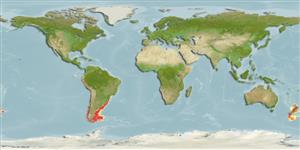Common names from other countries
Environment: milieu / climate zone / depth range / distribution range
Sinh thái học
Tầng đáy biển sâu. Tropical; 0°N - 90°S, 180°W - 180°E
Southeast Pacific and Southwest Atlantic: South America. Tropical to temperate.
Length at first maturity / Bộ gần gũi / Khối lượng (Trọng lượng) / Age
Maturity: Lm ? range ? - ? cm Max length : 260 cm TL con đực/không giới tính; (Ref. 1394); 220 cm TL (female); Khối lượng cực đại được công bố: 350.0 kg (Ref. 1394); Khối lượng cực đại được công bố: 350.0 kg
Found over the continental shelf and slope. Occurs in deep waters, and also venture into freshwaters in rivers and around glaciers. Feeds on many species of benthic and pelagic fishes, and invertebrates (i.e. lobster, krill, squid, octopus, and jellyfish), and occasionally penguins and young South American seals) (Ref. 1394). Preyed upon by a sevengill shark (Ref. 8910). Found over the continental shelf and slope. Occurs in deep waters, and also venture into freshwaters in rivers and around glaciers. Feeds on many species of benthic and pelagic fishes, and invertebrates (i.e. lobster, krill, squid, octopus, and jellyfish), and occasionally penguins and young South American seals) (Ref. 1394).
Jefferson, T.A., S. Leatherwood and M.A. Webber. 1993. (Ref. 1394)
IUCN Red List Status (Ref. 130435)
CITES status (Ref. 108899)
Not Evaluated
Human uses
Các nghề cá: Tính thương mại
FAO - Các nghề cá: landings, species profile | FishSource | Biển chung quanh ta
Các công cụ
Các nguồn internet
Estimates based on models
Preferred temperature
(Ref.
115969): 6.3 - 15.6, mean 9.9 (based on 922 cells).
Thích nghi nhanh
Chiêù cao, thời gian nhân đôi của chủng quần tối thiểu là dưới 15 tháng (K=0.31-0.31).
Vulnerability
Moderate to high vulnerability (51 of 100).
Price category
Unknown.
